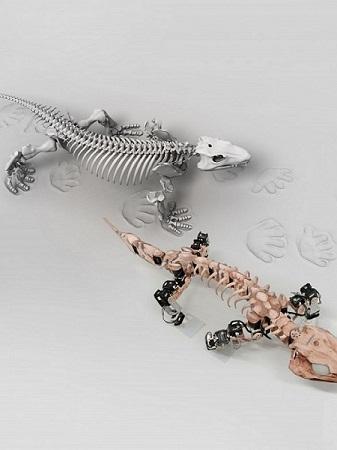Editor-in-Chief
- FMA
- The Fabricator
- FABTECH
- Canadian Metalworking
Our Publications
Categories
- Additive Manufacturing
- Aluminum Welding
- Arc Welding
- Assembly and Joining
- Automation and Robotics
- Bending and Forming
- Consumables
- Cutting and Weld Prep
- Electric Vehicles
- En Español
- Finishing
- Hydroforming
- Laser Cutting
- Laser Welding
- Machining
- Manufacturing Software
- Materials Handling
- Metals/Materials
- Oxyfuel Cutting
- Plasma Cutting
- Power Tools
- Punching and Other Holemaking
- Roll Forming
- Safety
- Sawing
- Shearing
- Shop Management
- Testing and Measuring
- Tube and Pipe Fabrication
- Tube and Pipe Production
- Waterjet Cutting
Industry Directory
Webcasts
Podcasts
FAB 40
Advertise
Subscribe
Account Login
Search
If only 3D printing were around 300 million years ago …
European researchers use additively manufactured parts to mimic the gait of extinct animals
- By Don Nelson
- February 6, 2019
- Article
- Additive Manufacturing
I’ve come across numerous stories lately about how 3D printing has improved the lives of severely injured animals:
• A college student 3D-printed a harness and set of wheels for a paralyzed ferret, restoring its mobility.
• “Stumpy” the duck received a new leg and foot after a run-in with a weasel.
• An animal surgeon implanted an additively manufactured titanium plate in the skull of a dachshund suffering from cancer.
Another recent story I’ve read isn’t about animal prostheses, but it is about additive manufacturing (AM) and animals—very, very old animals.
Researchers at the Swiss Federal Institute of Technology Lausanne (EPFL) and Humboldt University of Berlin joined forces to devise a methodology for identifying the likely gaits of extinct animals.
They studied the fossilized remains and footprints of an Orobates pabsti, a 1.5-meter-long reptile that lived approximately 300 million years ago. Based on the culled information, the researchers developed a computer simulation of how they thought the reptile moved. Then they designed and built a robot—OroBOT—that mimics the simulated motion.
The main structural parts of the robots are the servomotors, explained OroBOT’s designer, Kamilo Melo of EPFL’s Biorobotics Laboratory. “We encapsulate the motor in a 3D-printed part that provides the connecting link that goes to the next motor joint, and so on.”
Two key components are the robot’s pectoral and pelvic girdles. They each house four servomotors that power the legs. The tail and head are custom parts built from the actual bones of the fossilized reptile. The skull is an exact reconstruction of its head; it was hollowed out so the computer and other electronics would fit inside.
The AM parts were built from polyamide materials on a selective laser sintering (SLS) printer. EPFL team members embedded polyamides with aluminum and glass microspheres to try to increase structural strength. However, they found parts with embedded materials were heavier and made it harder to achieve the desired mass distribution.

Researchers designed a robot with 3D-printed parts that mimics the gait of a reptile that roamed Earth 300 million years ago.
When asked why AM was used to make OroBOT’s components, Melo replied: “We knew that 3D-printed materials were not always the best solution for a robotic platform, especially where more reliable materials should be incorporated for long-term applications. The robot could have been created, as many other robots we build are, using materials like aluminum or carbon fiber.
“But in this case, we also wanted to incorporate the aesthetic aspect. [AM] allowed us to create a nice skull and ribs along the robot spine, nice leg shapes, and to paint it with the colors we wanted,” he said.
About the Author

Don Nelson
2135 Point Blvd.
Elgin, IL 60123
(815)-227-8248
About the Publication
- Podcasting
- Podcast:
- The Fabricator Podcast
- Published:
- 04/30/2024
- Running Time:
- 53:00
Seth Feldman of Iowa-based Wertzbaugher Services joins The Fabricator Podcast to offer his take as a Gen Zer...
- Trending Articles
- Industry Events
16th Annual Safety Conference
- April 30 - May 1, 2024
- Elgin,
Pipe and Tube Conference
- May 21 - 22, 2024
- Omaha, NE
World-Class Roll Forming Workshop
- June 5 - 6, 2024
- Louisville, KY
Advanced Laser Application Workshop
- June 25 - 27, 2024
- Novi, MI



























